Love your lake? Let’s learn what lurks there
By Matt Ward
In order to accomplish great things, we have to take an honest look at where we are and decide on where we want to go.
This is no less true of lake and pond management than it is of life.
Knowing how things are in your pond at any point in time is the only way to be sure of what fishery management steps need to be taken and how a fishery is progressing over time.
Maybe you are planning pond stocking, wondering how pond weeds are affecting your fish, thinking about adding bass or trout, or wondering if you need to add forage fish.
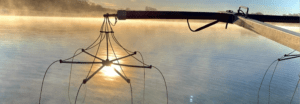
The right first step is to assess the current fish population in terms of numbers, types and size.
Multiple assessment tools have been developed over time including gill nets, hoop nets, seining, pole and line, and electrofishing.
All of these methods have a place and have been developed to move fishery analysis from the “yarn” to science. Each of the first four methods are generally biased to a specific type or size of fish, making general assessment difficult.
Electrofishing is the closest thing we have to a broad-spectrum fishery analysis tool. Electrofishing is somewhat biased toward shallow water fisheries, but generally offers the most complete analysis of the widest variety of fish in a given pond or lake.
That’s why we are giving away five free electrofishing surveys to lucky Texas pond owners. There is no better way to learn what lurks in your lake.
What is electrofishing?
Electrofishing involves the application of specific current to a given water body with the goal of temporarily stunning fish in order to safely collect them. Sampled fish are netted and analyzed as needed to assess the fishery.
After analysis, fish are safely returned to the water to swim away unharmed. Equipment to conduct this work is quite sophisticated and requires extensive experience to maximize sampling efficiency and minimize risk to fish. Desired current varies in each fishery, just as conductivity of waters varies across the country.

Our electrofishing equipment is optimized for scaled fish and involves a gas generator, which is connected to a rheostat that allows us to cycle between DC/AC, various electrical frequencies, and a wide variety of applied voltages.
These settings are combined with a variety of telemetry equipment that allows us to track amp pulls and the load on our generator at any given point in time. In addition to varying settings on the rheostat, we have a variety of different hardware settings we can use to manipulate our anodes and cathode to optimize our equipment to a given water body.
Electrofishing involves applying very powerful current to water and as such involves significant risk. This risk is managed by crew training and safety policies that ensure the safety of our customers and ourselves.
Be sure to pay attention to safety instructions given prior to an electrofishing survey.
What information is collected?
Sampled fish are recorded for species and relative abundance. Next, the relative size distribution of all species is recorded. Specific gamefish are then measured and weighed to determine their relative body condition. This data is recorded and plotted against standards that have been set in scientific literature.
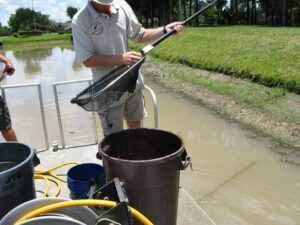 In addition to these direct observations, every decent fishery manager should be making many secondary observations that are critical to developing management strategies.
In addition to these direct observations, every decent fishery manager should be making many secondary observations that are critical to developing management strategies.
These include aquatic vegetation, non-living cover, water temperature, clarity, depths, predator signs, and access. All fishery assessments should also include a basic water quality analysis to check for buffering capacity and nutrient loading.
What information is gleaned from this data?
Fisheries managers use this information to understand the general species composition of a particular fishery.
Combining that with relative size data, managers are able to provide a good understanding of the forage availability for various gamefish. Gamefish data allows for an understanding of the size structure of a population and the relative health of gamefish of various sizes.
Ultimately, this data is used to determine the predator-to-prey ratios and general forage availability. In short, we find out what your fish are eating and if they have enough to eat; if you have enough fish in your lake to enjoy the fishing; if you are getting hit by predators; and the list goes on.
This information allows us to figure out what the best fish to stock would be and how many of those fish could be stocked. This kind of analysis can easily save a pond owner many thousands of dollars per acre that could be wasted by stocking “blind.”
When To Shock
The best time to shock a lake is when you need to understand the state of that fishery.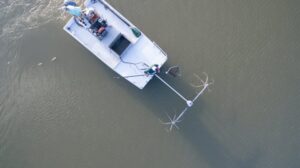
This can really be done most any time of the year with one general exception. Hot weather is hard on fish, so generally we try to avoid shocking most lakes in the heat of summer (but even this rule has exceptions).
In a perfect world, we shock all lakes annually in the fall to understand trends. The fall is preferred because standard fish data is also collected in the fall giving the best possible picture of the state of a given fishery.
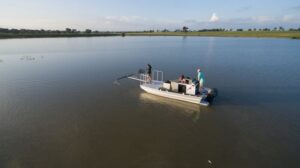 That being said, we shock throughout most of the year to assess loss to predation, the strength of a spawn, fish loss due to a flood, and to conduct selective harvest.
That being said, we shock throughout most of the year to assess loss to predation, the strength of a spawn, fish loss due to a flood, and to conduct selective harvest.
There are also specialty shocking events that can serve specific purposes. My favorite is the pre-spawn shock for largemouth bass. Because largemouth bass females peak in weight and move shallow just before the spawn, this is the best time of year to go looking for trophies!
Final Thoughts
Electrofishing is a very safe method for sampling fish by stunning fish for short periods of time while data is collected. Check out our video of the process here.
Note that fish can occasionally be killed by the stress of electrical shock or by getting hit by the electrofishing boat’s propeller, but this loss is very rare.
Efficiency does vary though, and it should be noted that standard professional electrofishing is highly effective on scaled fish that inhabit shallow water and somewhat less effective on deep water denizens such as crappie or scaleless fish such as catfish.
All in all, if you love your lake, schedule an electrofishing survey and find out how to make your fishery shine.
Why Choose Lochow Ranch for Pond & Lake Management
Serving Texas, Oklahoma, Arkansas and Louisiana, Lochow Ranch Pond & Lake Management proudly puts more than two decades of experience to work for you. Our team includes biologists, technicians and other professionals with deep expertise in pond and lake management services.
Check us out if you are considering building a lake, looking for pond stocking services, to buy fish for a pond, or getting professional pond management and maintenance or fishery management. Our services include lake design, pond construction, pond renovation, pond water testing, electrofishing, pond stocking, control of pond weeds, and pond liming and fertilizing. Let us help you build your dream pond that will delight your family and friends for generations to come.
Click here to get in touch to get started today.
Matt Ward is a Fishery Biologist for Lochow Ranch Pond & Lake Management. He has a Master of Science in Biochemistry from Texas A&M University and has worked in fisheries management in Texas for 15 years. He brings a passion for good science and an interdisciplinary approach to the natural sciences to help property managers steward their aquatic resources and achieve management objectives.
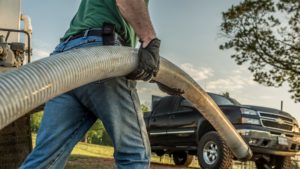 Careful selection of the timing of introduction, species, and numbers of fish stocked is key to producing the kind of fishery a lake manager wants. A good pond stocking plan should take into account expectations during a drought, the desired fishery outputs, water body physical composition and available cover. A good pond stocking plan should also be preceded by water testing to make sure all is in order.
Careful selection of the timing of introduction, species, and numbers of fish stocked is key to producing the kind of fishery a lake manager wants. A good pond stocking plan should take into account expectations during a drought, the desired fishery outputs, water body physical composition and available cover. A good pond stocking plan should also be preceded by water testing to make sure all is in order.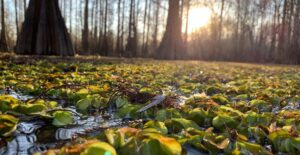
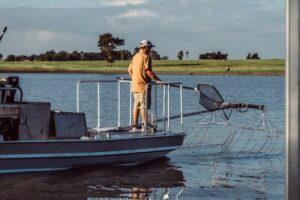
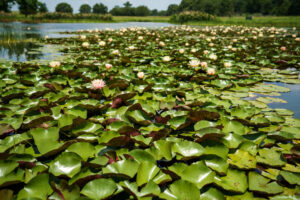 Fertilization is recommended from March-September.
Fertilization is recommended from March-September.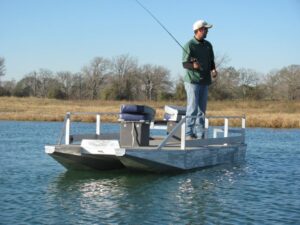 These months are the best time to just chill out and enjoy your lake or pond if you’ve been on top of your fishery management needs.
These months are the best time to just chill out and enjoy your lake or pond if you’ve been on top of your fishery management needs. What kinds of fish will work best in your body of water involves many variables, including your own goals for your pond or lake. For example, you need to carefully assess the impact of introducing non-native species into your pond. It’s important to be aware of the fish types that can live together in harmony so your pond can sustain a healthy eco-system.
What kinds of fish will work best in your body of water involves many variables, including your own goals for your pond or lake. For example, you need to carefully assess the impact of introducing non-native species into your pond. It’s important to be aware of the fish types that can live together in harmony so your pond can sustain a healthy eco-system.
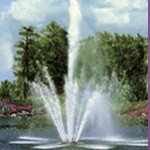 In order to avoid catastrophe, pond and lake owners currently should be inspecting aeration and
In order to avoid catastrophe, pond and lake owners currently should be inspecting aeration and 
Recent Comments